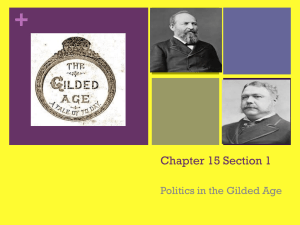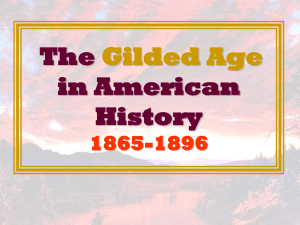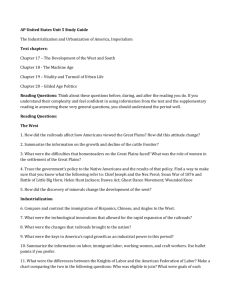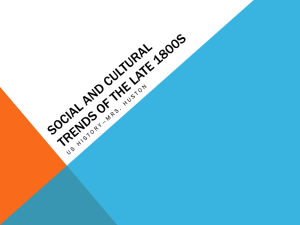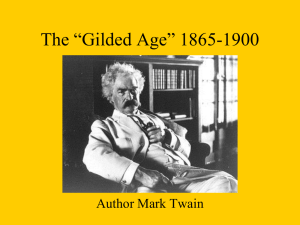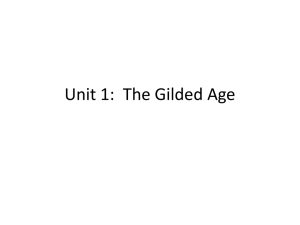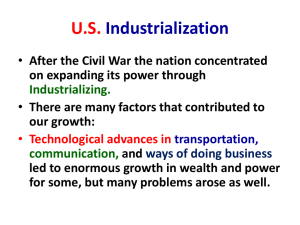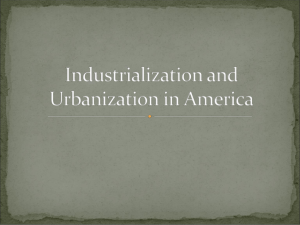Unit 6 Gilded Age Notes
advertisement
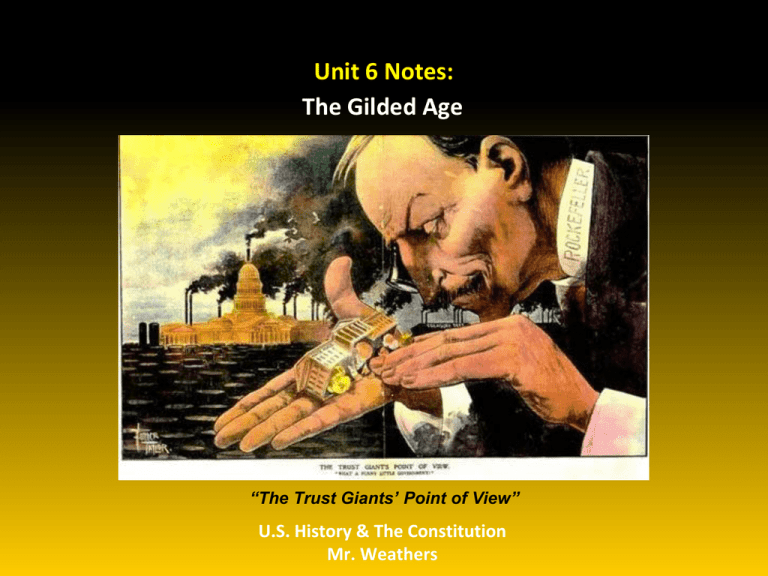
Unit 6 Notes: The Gilded Age “The Trust Giants’ Point of View” U.S. History & The Constitution Mr. Weathers Daily “Bell Ringer” Warm Up 2nd Nine Weeks Bell Ringer #7 (11 & 12 Dec) 7.) How did Plessy v. Ferguson (1896) affect the rights of African Americans? a.) It declared the doctrine of “separate but equal” constitutional. b.) It forced colleges to admin persons of all races. c.) It established harsh punishment for businesses that discriminated against African Americans. d.) It forced the South to repeal Jim Crow laws such as the poll taxes & eight box laws. CORRECT ANSWER: A Today’s Lesson Standard / Indicator Standard USHC-4: The student will demonstrate an understanding of the industrial development & the consequences of that development on society & politics during the second half of the nineteenth & the early twentieth centuries. USHC-4.1: Summarize the impact that government policy & the construction of the transcontinental railroads had on the development of the national market & on the culture of Native American peoples. USHC-4.4: Explain the impact of industrial growth and business cycles on farmers, workers, immigrants, labor unions, & the Populist movement & the ways that these groups & the government responded to the economic problems caused by industry & business. Railroads Expand West 1.) 1870 – 1900: generous federal land policy & completion of transcontinental railroad lines made rapid settlement of the West possible. 2.) Railroad linked the Atlantic & Pacific coasts of the U.S. in 1869. Allowed for the expansion of settlers, goods, & markets west. 3.) By 1884, 5 transcontinental railroads crossed the U.S. 4.) Railroad companies sold land to farmers to help raise capital (money) & encourage settlement in the West. May 10, 1869, with the ceremonial driving of the "Last Spike" at Promontory Summit, Utah Railroads Expand West Cont. First Transcontinental R.R. (1869) Transcontinental Railroads by 1900 Railroads Expand West Cont. 5.) The growth of railroads westward allowed for: - Industries to grow rapidly = keep up with the railroads demand for parts, - Fostered the growth of cities & towns. - Established new markets in the West. Settlement of the West 6.) Homestead Act (1862): provided 160 acres to heads-of-household that took their family to settle in the West. 7.) Conflict arose between the Native Americans of the Great Plains & settlers that moved west. - Settlers argued that Native Americans had forfeited their rights to the land because they had not improved it. Homesteaders & Their “Soddy” Kansas Exodusters “Indian Wars” - Movement west led to “Indian wars” between homesteaders & Native Americans. Clashes led to numerous massacres throughout the late 1800s. - Among these: Sand Creek, Fetterman & the Wounded Knee massacres. Plight of the Native Americans 8.) Native American tribes of the Great Plains were relocated to reservations as territorial conflict between the Indians & settlers increased. 9.) Many American sympathizers to the plight of the Native Americans supported assimilation, which encouraged a minority groups adoption of the beliefs & way of life from a dominant culture. Native American Assimilation into American Culture. Reservation System Current Reservation System Indian Agent Plight of the Native Americans 10.) U.S. Government passed the Dawes Act in 1887. - Broke up reservations & gave 160 acres to the head of household & 80 acres to unmarried adults. - The government sold the remaining land & allowed the Native Americans to buy farm implements. 11.) Native Americans made no money from the land to settlers from the Dawes Act. 12.) The near extinction of the buffalo by white settlers brought an end to the traditional lifestyle of the Great Plains Indians. Plight of the Native Americans “Dawes Act” in Action Plight of the Native Americans Piles of buffalo hides ready for shipment to the East, & a “hill” of buffalo skulls. Rise of the Populist Party 13.) The late 1800s brought a viscous economic cycle that trapped farmers. - Crop Prices were falling. - Farmers mortgaged their farms to buy more land & produce more crops = prices fell more. - Banks were foreclosing on mortgages as farmers couldn’t pay back their loans. - Railroads were charging excessive prices for the shipping & storage of crops. Rise of the Populist Party 14.) The Grange was a farmer created organization that pushed railroad reform, including teaching members how to organize, setting up cooperatives, & sponsored state legislation to regulate railroads. 15.) The Populist Party was created in 1892 as the “People’s Party” to represent farmers & the working class. Rise of the Populist Party 16.) Economic & governmental reforms proposed by the populists included: - An increase in the money supply = rise in prices for goods & services. - A graduated income tax & federal loan program. - Election of senators by popular vote & single terms for presidents /vice pres. - A secret ballot to end vote fraud. - Eight hour workday & restrictions to immigration. Rise of the Populist Party 17.) The 1896 presidential campaign brought forth the issue of what precious metal would back the nation’s money. - Populists aligned themselves with the “silverites” that believed in bi-metallism, which backed money with both silver & gold = stimulate the economy, & the free coinage of silver. - “Gold bugs” supported the backing of dollars only with gold. 18.) William Jennings Bryan was nominated as the Democratic candidate for the 1896 election & backed by the Populists. William Jennings Bryan Election of 1896 McKinley & the Gold Standard - Republican William McKinley supported the gold standard. - Strengthen the value of the dollar & big business. Election of 1896 19.) Bryan expressed his support for bimetallism in his “Cross of Gold” speech. 20.) Ultimately, Republican William McKinley won the 1896 election & ended the Populist movement. 21.) The two legacies left by the Populists included: - The downtrodden could organize & have political impact. - An agenda of reforms, which carried on into the 20th century. (Progressive Era roots) “Cross of Gold” – Williams Jenning Bryan “Having behind us the commercial interests & the laboring interests & all the toiling masses, we shall answer their demands for a gold standard by saying to them, you shall not press down upon the brow of labor this crown of thorns. You shall not crucify mankind upon a cross of gold.” – William J. Bryan Gold Triumphs over Silver 1900 → Gold Standard Act. confirmed the nation’s commitment to the gold standard. A victory for the forces of conservatism. Republicans would dominate politics the next decade 1896 Campaign Buttons Are you a “silverite” or a “gold bug”? Part Two - The Rise of American Industry (American Industrial Revolution) Today’s Lesson Standard / Indicator Standard USHC-4: The student will demonstrate an understanding of the industrial development & the consequences of that development on society & politics during the second half of the nineteenth & the early twentieth centuries. USHC-4.2: Analyze the factors that influenced the economic growth of the United States & its emergence as an industrial power, including the abundance of natural resources; government support & protection in the form of railroad subsidies, tariffs, & labor policies; & the expansion of international markets. USHC-4.3: Evaluate the role of capitalism & its impact on democracy, including the ascent of new industries, the increasing availability of consumer goods & the rising standard of living, the role of entrepreneurs, the rise of business through monopoly & the influence of business ideologies. USHC-4.5: Explain the causes & effects of urbanization in late nineteenthcentury America, including the movement from farm to city, the changing immigration patterns, the rise of ethnic neighborhoods, the role of political machines, & the migration of African Americans to the North, Midwest, & West. Presidents of the Gilded Age During the Gilded Age, it can be argued that the presidents of the United States had less power than the business leaders. James Garfield Chester A. Arthur Grover Cleveland Benjamin Harrison - The policies & actions of the government during the Gilded Age gave large corporations the freedom to do most whatever it wanted, leading to an industrial boom in the U.S. Inventors & Inventions Alexander Graham Bell Samuel F.B. Morse "Mr. Watson -come here - I want to see you." Inventors & Inventions Thomas Edison George Westinghouse Natural Resources Drive Industrialization The “Robber Barons” (Captains of Industry) Entrepreneurs & Industrialists like Cornelius Vanderbilt, Andrew Carnegie, John D. Rockefeller & J.P. Morgan were able to build great fortunes during the Gilded Age Railroads Cornelius Vanderbilt Steel Andrew Carnegie Oil John D. Rockefeller The government created policies to support the industrialists • High tariffs led to lower prices for American made goods • There were very few government regulations on big business • Government supported owners over workers in labor disputes Banking J.P. Morgan “History Repeats Itself – The Robber Barons of the Middle Ages & the Robber Barons of To-Day.” Introduction of the “Trusts” - By 1900, a few large corporations, called "trusts", dominated in steel, oil, sugar, meat & farm machinery. - Used "vertical integration" to control each aspect of the production = ensured that the profits made on the finished product were maximized. - Controlled access to the raw materials = prevented opponents from entering the marketplace. - End result - sole producer of a certain manufactured good & no competition in the marketplace to lower prices. John D. Rockefeller & Standard Oil Co. Rise of Monopolies - Monopoly = having exclusive control of a commodity or service in a particular market, or a control that makes possible the manipulation of prices. Rockefeller Political Cartoon “What a Funny Little Government” by Horace Taylor The Verdict Magazine (Sept 1899) Horizontal vs. Vertical Integration Rockefeller (early) Carnegie (& later Rockefeller) The Bessemer Process - The Bessemer Process was the first inexpensive industrial process for the mass-production of steel. - By the late 1880s an immigrant by the name of Andrew Carnegie used this process to become a millionaire. The Gospel of Wealth - Many believed that those who profited from society owed something in return. This philosophy of giving back to society became known as the “Gospel of Wealth”. - The Captain of Industry who most believed in the Gospel of Wealth was Andrew Carnegie, who gave millions of dollars to numerous charities. Finance Capitalists - 1892: Morgan arranged the creation of General Electric through the merger of Edison General Election & ThomsonHouston Electric Company. - 1901: he formed the U.S. Steel Corporation by buying Carnegie Steel from Andrew Carnegie for $487 million & consolidating it with several other steel & iron companies. - U.S. Steel became the first billiondollar company in the world with $1.4 billion in authorized capital. J.P. Morgan Protective Tariffs & Social Darwinism - High import/export Tariffs taxed foreign imports & made it easier for US businesses to sell their products. - Europeans resisted buying US crops because of higher prices = farmers suffered. - Economic depressions occurred in 1873 & 1898. - Social Darwinism: belief that life was a battle of survival of the fittest. - Many business leaders adopted this philosophy to their business practices. - Many Christians rejected this philosophy as it went against their beliefs. Free Enterprise System - The free enterprise system is the economic system in which citizens are free to run a business the way they want. - The system is based on the laissezfaire theory, meaning a business will succeed or fail & the government will not interfere. The free enterprise system allowed the U.S. to become a world industrial giant in the late 1800s & led to numerous new inventions. The Gilded Age - The era was called the Gilded Age because although life in the U.S. looked bright & shiny, underneath the surface, there was lots of poverty & corruption. Mark Twain’s novel, The Gilded Age Rise of industry in the “New South” - During the Gilded Age, the South attempted to modernize & embrace industrialization. Interior of a southern Textile Mill - Textile manufacturing became the dominant industry in the South during this time. Interstate Commerce Act (1887) - Created the Interstate Commerce Commission. - In response to Wabash v. Illinois, Congress passed a law that rates must be reasonable & just (fair) - Made it illegal to charge higher rates for shorter hauls (prohibited discriminating against small markets) - Ineffective because there was no enforcement of the law Sherman Antitrust Act (1890) - Made it illegal to combine a company Into a trust or conspire to restrain trade or commerce. - Made monopolies illegal. - The law was ineffective because it was vague & the courts did not enforce it. “The Bosses of the Senate”Puck Magazine, 1889 "One sees his (Uncle Sam's) finish unless good government retakes the ship" Part Three - Immigration/migration - Politics - The Labor Movement “Rags to Riches” & the “American Dream” - Immigrants came to America with the hope they could become rich & successful if they worked hard enough. - Novelist Horatio Alger wrote stories where the main character went from “rags to riches.” - Going from “rags to riches” became known as achieving “The American Dream”. Migration & Population Shifts - The Post Reconstruction South saw limited job availability in textile mills for African Americans. - The South was in an agricultural depression with crop failures. - Social discrimination – Jim Crow Laws & increasing violence. - Many African Americans moved from the rural (country) areas of the South to the urban (city) areas of the NE & Midwest U.S. - Usually last hired & first fired. - Used as “strikebreakers” = resentment by factory workers. - Many African Americans moved to the West (i.e. Kansas’ “Exodusters”). Anti-Immigrant Reaction: Nativism - Nativism: political position demanding favored status for certain established inhabitants of a nation vs. newcomers or immigrants. - Nativists opposed immigration & supported efforts to lower the political or legal status of specific ethnic/cultural groups. - Many felt immigrants couldn’t be assimilated & threatened jobs for Americans. “The Proposed Immigrant Dumping Site” Cover of Judge Magazine, 1890 Chinese Exclusion Act 1882 - The Chinese Exclusion Act prevented Chinese immigrants from legally coming to the United States. - It was not repealed until 1943. “The Only One Barred Out” Child Labor - The common practice of using child labor in factories during the Gilded Age brought issues of abuses to light. - Working twelve+ hour days & six day weeks. - Drawing children into the endless cycle of poverty. - Many children simply missed out on their childhood. Tenements in New York City “Dumbbell” Tenements in New York City 1870s Political Machines - Political machines controlled the activities of political parties in the city. - Ward bosses, precinct captains, & the city boss worked to: 1) ensure that their candidates were elected. 1) make sure that city government worked to their advantage. - The “machines” exchanged jobs, housing, citizenship, favors, etc. for immigrants’ political votes & loyalty - Graft, kickbacks, & corruption were the standard. 1870s Political Machine Organization - Like a pyramid: local precinct workers & captains at the base, ward bosses in the middle, & the city boss at the top - City Boss = Power broker (most were democrats & many were immigrants themselves) William Marcy "Boss" Tweed 1869-1871 – “Tweed Ring” “The Brains” Thomas Nast “The Tammany Tiger Loose” by Thomas Nast Thomas Nast - Political cartoonist for Harper’s Weekly. - He attacked the Tammany Hall (Democratic) political machine that ran New York City in the late 1800s . - He created the Democratic Donkey (he did not like the Democrats), & the Republican Elephant symbols, the Tammany Tiger, & even Santa Claus. Republican Elephant Democratic Donkey Santa Claus Patronage & Civil Service Legislation - Patronage: act of giving government jobs to supporters of the winning party in an election (Spoils System”). - Reformers pushed for adoption of a merit system (hiring the most qualified for jobs). - The Pendleton Civil Service Act of 1883 authorized a bipartisan commission to make appointments for federal jobs based on performance. - Applicants required to take a civil service examination for government jobs. Rise of Early Unions - Free enterprise system = businesses made their own rules. - No government interference = business owners could pay workers what they wanted & make them work as long hours. - Industrialization contributed to the development of organized labor because it created low-wage, low-skill jobs that made employees easy to replace. - Many Union organizers were blacklisted = impossible for them to get a job. - Businesses locked workers out & refused to pay them. - Workers were forced to sign “yellow dog” contracts saying they would not join a union. Key Labor Leaders - Eugene V. Debs was the powerful leader of the American Railway Union. - Debs ran for president four times as a candidate for the Socialist Party. - Samuel Gompers was the first leader of the American Federation of Labor; a union of over 20 trade unions. - He believed unions should stay out of politics & should negotiate rather than strike. Great Railroad Strike of 1877 - 1877, an economic recession led to some railroads cutting wages, triggering the first nationwide labor strike. It became known as the Great Railroad Strike. - Some workers turned violent & numerous states had to call out their state militias to stop the violence. First Union - Knights of Labor - In response to the Great Railroad Strike of 1877, labor organizers formed the first nationwide industrial union – the Knights of Labor. - The Knights called for an eight-hour workday, supported the use of arbitration & began to organize strikes. Haymarket Riot - The Haymarket Riot - disturbance that took place on May 4, 1886, in Chicago, - began as a rally in support of striking workers. - A bomb was thrown during the rally, which started a riot. Eight men were convicted; four were executed. One was a member of the Knights of Labor. Homestead Strike (1892) - Homestead Strike: workers of Andrew Carnegie’s U.S. Steel went on strike after a tense labor dispute led to a lockout. - One of the most violent strikes in U.S. history & a major setback for unions. Pullman Strike - The Pullman Strike: a nationwide conflict between labor unions & railroads that occurred near Chicago in 1894. - Organized by Eugene V. Debs after union workers were fired. - Shut down the nation’s railroads & threatened the economy. “The Condition of the Laboring Man at Pullman” Impact of Union Strikes - Union membership declined as many people saw unions as being Un-American & violent (anarchists). Groups that Suffered During the Gilded Age Native Americans - Native Americans were forced onto reservations & their children were forced to assimilate into American culture Groups that Suffered During the Gilded Age African Americans Blacks were denied many basic rights and lynching of blacks was a common occurrence in the South Groups that Suffered During the Gilded Age Farmers - Overproduction of goods and price gouging by railroads drove many farmers out of business. Groups that Suffered During the Gilded Age Immigrants - Many immigrants were discriminated against & most lived in horrible inner city conditions. Groups that Suffered During the Gilded Age Women - Women were denied the right to vote in most states and could not work the same jobs as men. Groups that Suffered During the Gilded Age Children - Most children lacked good educations because they went to work after they learned to read & write.
